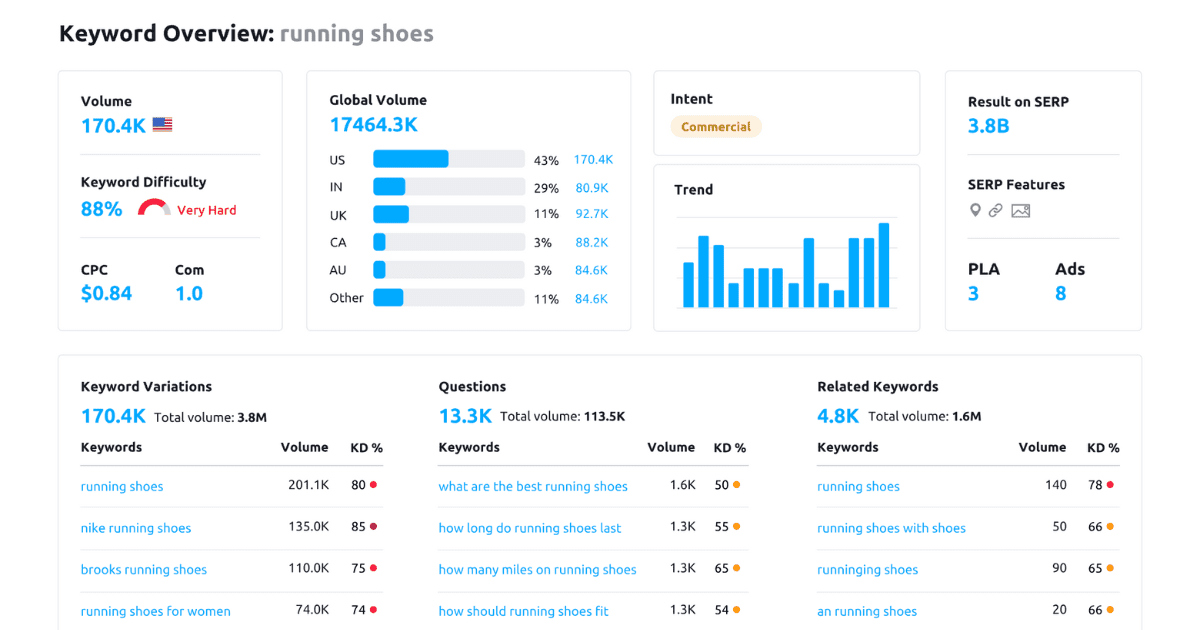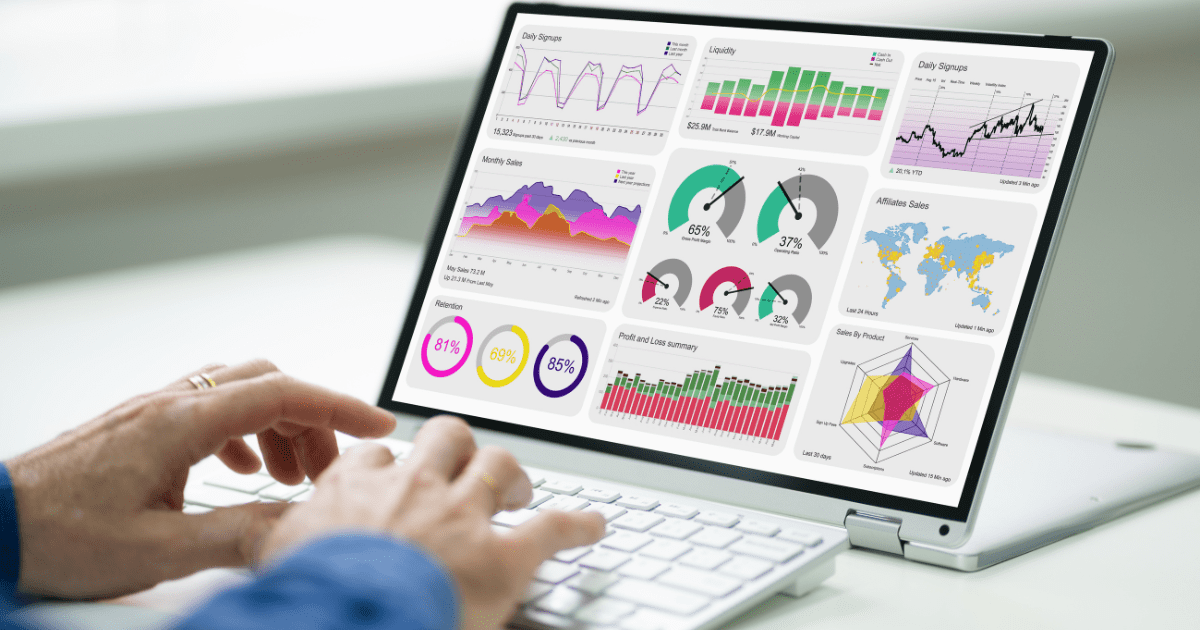Search Engine Optimization (SEO) is a constantly evolving field that can overwhelm business owners and marketers. With algorithms changing frequently and competition becoming fiercer, staying on top of the latest trends and strategies is essential.
In this guide, we’ll break down the 13 most crucial SEO components every brand should focus on. From understanding search intent to optimizing for mobile, we’ll provide valuable insights and practical tips to help you navigate the complex world of SEO.

#1 – Keyword Research and Targeting
Identify High-Potential Keywords
The cornerstone of any successful SEO strategy lies in meticulous keyword research. This crucial step entails pinpointing specific keywords or phrases that resonate with your target audience’s search queries for products or services akin to what you offer.
For example, if you own a quaint local bakery, relevant keywords could encompass terms like “local bakery,” “freshly baked bread,” or “delicious gluten-free pastries.” Leveraging tools such as Google Search Console can furnish valuable insights into the precise search queries that direct users to your website.
Some other popular methods for identifying high-potential keywords include using keyword research tools like Ahrefs, SEMrush, or Moz. These tools provide a comprehensive list of potential keywords based on search volume, competition level, and other relevant metrics.
Optimize Pages for Target Terms
Once you’ve identified your high-potential keywords, the next step is to incorporate them naturally into your content. This is where the concept of on-page or on-site SEO comes into play. It refers to the practice of optimizing individual web pages to rank higher in search engine results pages (SERPs).
However, be wary of keyword stuffing, an outdated practice that can lead to penalties from search engines. Instead, create content that seamlessly integrates your chosen keywords.
Consider Long-Tail Keywords
While short-tail keywords (1-3 words) may have high search volumes, they also face fierce competition. Opting for long-tail keywords (3+ words) can provide a more targeted and less competitive approach to keyword targeting.
These longer phrases typically indicate higher search intent and often lead to higher conversion rates, making them a strategic choice for businesses looking to optimize their online presence and attract qualified leads.
By leveraging long-tail keywords, companies can tailor their content to match user search queries better, improving their visibility and driving quality website traffic.
Taking Cues From Your Competitor
Analyzing your competitors’ keywords is an excellent way to gain insights into their SEO strategies. Tools like SpyFu or SimilarWeb can help identify which keywords your competitors are targeting and how well they rank for them.
However, don’t blindly copy their strategy; instead, use this information to refine and optimize your keyword research process continually.
#2 – On-Page Optimization: Title Tags, Meta Descriptions, and Headings
Keyword Optimization Best Practices
Metadata like Title tags, meta descriptions, and headings are all crucial on-page SEO elements where your keywords should appear. Title tags tell search engines what your page is about and appear as the clickable headline in SERPs. Meta descriptions provide a brief summary of your web page content, while headings structure your content and make it easier for search engines and users to navigate.
When optimizing these elements, it’s essential to maintain a balance between including your target keywords and writing compelling, informative copy that entices users to click through. Remember, these elements are often the first thing users see when searching for relevant content, so make them count!
Clear Page Structure and Hierarchy
A well-structured website enhances user experience and plays a crucial role in boosting your site’s visibility in search engine rankings.
By strategically using header tags (H1, H2, H3, etc.) to establish a clear hierarchy, creating a concise and SEO-friendly URL structure, and implementing effective internal linking strategies, you can guide visitors seamlessly through your site while also improving your site’s overall search engine optimization (SEO) performance.
Correct hierarchy also means putting the headings in the right semantic order, with the first H2 tag as the most important and subsequent headings in decreasing importance.

#3 – Internal Links
Internal links, or links that connect one page on your website to another, play a vital role in establishing a well-structured, easy-to-navigate site.
They contribute significantly to your website’s visibility and SEO performance by helping search engines understand the relationship between different pages and your site’s overall structure.
Internal links also influence how search engine algorithms distribute ranking power throughout your site. By directing this so-called “link juice” to specific pages, you can emphasize their importance and improve their visibility in search results.
Crafting Effective Internal Links
Creating effective internal links requires a strategic approach. Here are some tips:
- Use Descriptive Anchor Text: Anchor text guides users through hyperlinks. Ensuring that the clickable text is relevant to the linked page provides both users and search engines with a clear understanding of the linked content’s context and relevance.
- Link to Important Pages: When selecting pages to link to, prioritize those with significant value for your website or business. These may include pages with high-converting content, essential product/service information, or key landing pages that drive user engagement and conversions.
- Keep It Natural: Integrating links seamlessly into your content is vital for maintaining a user-friendly experience and supporting your SEO strategy. Avoiding forced or unnatural placements helps preserve the flow of your content, enhances user engagement, and prevents any adverse effects on your search engine optimization efforts.
#4 – High-Quality and Relevant Content Creation
Craft Useful, Informative Content
Creating useful and informative content is a cornerstone of an effective SEO strategy. According to a study by HubSpot, businesses that prioritize blogging are 13x more likely to achieve a positive ROI on their efforts.
This statistic underscores the importance of providing value to your audience through your content. Whether it’s a blog post, infographic, or video, your content should answer questions, solve problems, or provide new insights to your readers.
Address Searcher Intent and Needs
Understanding and addressing searcher intent is crucial for creating relevant content. This involves figuring out why someone is searching and what information they’re looking for.
For example, if someone searches for “how to bake a cake,” they’re likely looking for step-by-step instructions, not a company selling cake mix. By aligning your content with search intent, you can attract more relevant traffic and increase your chances of ranking higher in search results.
Partner with an Agency for Consistent Content Creation
Consistently creating high-quality content can be challenging for businesses. Explore collaborating with a digital marketing agency offering content writing services to craft and implement a content strategy aligning with your business objectives and effectively targeting your audience.
With their expertise in SEO best practices and content creation, an agency can help you consistently publish valuable content that drives traffic, engages your audience, and improves your search engine rankings.

#5 – Link Building and Backlink Quality
Earn Links from Authority Domains
Link building remains one of the most crucial off-page SEO components. When other trustworthy sites link to your content, it tells search engines that your site is a reputable source of information, enhancing your search visibility. However, not all links are created equal.
Earning links from high-authority domains can significantly boost your SEO. These sites have earned their status by consistently publishing quality content and garnering numerous backlinks.
Prioritize Relevance Over Quantity
While link building often focuses on quantity, SEO professionals emphasize the importance of relevance. Off-site SEO factors include the relevancy of the sites linking to you.
Therefore, building links with sites in the same or related industries can be more beneficial for your SEO than gaining many links from unrelated sources. This approach ensures the links you earn will likely be valued by search engines and contribute positively to your SEO strategy. This way, your backlink profile can also stay more natural and authentic.
#6 – Mobile-Friendly Website Design
Optimized Layouts for Any Device
Search engine optimization is not confined to desktops. In the era of smartphones and tablets, having a mobile-friendly website is paramount for SEO success.
Search engines, including Google, have always adopted a mobile-first indexing approach, meaning they predominantly use the mobile version of the content for indexing and ranking.
Therefore, your website should have a responsive design that adapts to any device—desktop, tablet, or smartphone—providing an optimal viewing experience for all users.
Fast Loading Times
A slow-loading mobile site can be incredibly frustrating for users and can significantly harm your SEO endeavors. To combat this issue, optimizing your website for speed is crucial, ensuring that pages load swiftly and seamlessly across all devices.
This optimization process may entail various strategies, such as compressing images to reduce file sizes, leveraging browser caching to store temporary web files locally, or minimizing bulky JavaScript and CSS files.
By implementing these techniques effectively, you can create a fast-loading site that enhances user experience and contributes to lower bounce rates and improved rankings in search engine results pages.

#7 – Page Load Speed and User Experience
Image Compression and Caching
Page load speed is a critical factor in user experience and a ranking factor for search engines. One way to improve load speed is by compressing images on your site. High-resolution images can slow down your page significantly. Using tools for image compression can reduce the file size without compromising on quality.
Additionally, implementing browser caching can speed up load times for returning visitors. This technique involves storing parts of your website in the user’s browser so that they don’t need to download the same information each time they visit your site.
Minimal Server Response Times
Reducing server response time is another essential aspect of improving page load speed. According to Google/SOASTA Research, 2017, as page load time goes from one to three seconds, the probability of bounce increases by 32%. This indicates that even a second’s delay can cost you valuable traffic.
One method to minimize server response times is to use high-quality web hosting services. These services can handle high traffic volumes and provide consistent server performance. Regularly monitoring your website’s speed and performance can help identify any issues and ensure a smooth user experience.
#8 – Technical SEO: Site Structure, Crawling, and Indexing
Understanding Site Structure
The architecture and organization of your website are crucial ranking factors that significantly influence its user-friendliness and the efficiency with which search engines can navigate and index it.
By implementing a thoughtfully structured site layout, you not only facilitate search engines in comprehending the overarching theme of your content but also enable them to establish meaningful connections between different pages on your site.
Consequently, this optimization can lead to improved visibility and ranking on search engine results pages (SERPs), potentially driving more traffic and enhancing your online presence.
The Importance of Crawling and Indexing
Crawling and indexing are two core components of technical SEO that ensure your web pages appear in search results.
When search engines ‘crawl’ your website, they take a snapshot of each page to understand what’s on it and how it might be relevant to various search queries. They then ‘index’ this information to match search queries with relevant pages.
To ensure efficient crawling and indexing, ensure your site has a clear hierarchy, internal linking structure, and a sitemap that helps search engines find and index your content easily. Regularly check for crawl errors or duplicate content issues that could harm your rankings.

#9 – SEO-Friendly URL Structures
Descriptive Filenames and Paths
An SEO-friendly URL is crucial for enhancing user experience and search engine visibility. By crafting a URL that includes your primary keyword and offers a descriptive preview of the page content, you create a pathway that guides users and search engines to understand the page’s purpose.
To back this claim, URLs that contain terms similar to a keyword have a 45% higher click-through rate than URLs that don’t. This statistic is highly relevant to the keyword optimization best practices sub-section. It would reinforce our focus on actionable insights while demonstrating the impact of well-crafted title tags on user engagement.
For instance, a URL such as ‘www.example.com/seo-strategy-guide‘ not only conveys the topic clearly but also improves the overall user engagement by providing a concise and relevant link structure, unlike generic URLs that may lack context and relevance like ‘www.example.com/article12345‘.
Avoid Excessive Parameters
While parameters in a URL can be useful for tracking click sources and categorizing page content, excessive use can make your URL confusing and less appealing to users and search engine algorithms. Aim for simplicity and readability in your URLs, keeping them as short and concise as possible without sacrificing necessary information.
Adopting a logical and consistent naming convention for parameters can also make your URLs easier to understand and remember. Moreover, avoid using dynamic characters like question marks and ampersands in your URLs, as they can cause issues with indexing and ranking.
#10 – EAT (Expertise, Authoritativeness, and Trustworthiness)
Establish Credibility Through Expertise
In the realm of SEO, EAT is a framework used by Google’s search quality evaluators to assess the value of web content.
The ‘Expertise’ component refers to the depth of knowledge exhibited in your content. Creating content that demonstrates a high level of expertise in your field is important to establish credibility. This involves thorough research, using industry-specific language where appropriate, and providing unique insights based on your experience or studies.
According to Search Engine Journal, Google uses EAT as a benchmark for YMYL (Your Money Your Life) pages containing information that could impact a person’s health, finances, or safety. This illustrates the importance of expertise in content creation, particularly in sectors where accuracy and depth of knowledge are paramount.
But EAT is a factor for non-YMYL content as well, as expertise can help distinguish your brand and content from competitors in any field. Therefore, consistently demonstrating a high level of expertise can improve your website’s credibility and authority in the eyes of both search engines and users.
Showcase Authorship and Credentials
The ‘Authoritativeness’ and ‘Trustworthiness’ components of EAT (Expertise, Authoritativeness, Trustworthiness) play crucial roles in establishing credibility for your website. To demonstrate Authoritativeness, consider showcasing the credentials and expertise of your content creators.
If they are recognized experts in their respective fields, ensure this is prominently highlighted.
Furthermore, Trustworthiness can be built by emphasizing any acknowledgments or endorsements your website has garnered from reputable sources through inbound links. Doing so reinforces your site’s authority and reliability, bolstering its standing in the digital landscape.

#11 – Regular Monitoring and Analytics Analysis
In the world of SEO, data is your guiding light. Regular monitoring and analysis of your analytics can provide invaluable insights into the effectiveness of your SEO strategy.
Tracking your rankings for targeted keywords allows you to understand how your SEO efforts impact your visibility in search engine results. Additionally, monitoring your website traffic can help identify which sources drive the most visitors, whether organic search, social media, or referral traffic.
Engagement metrics, such as bounce rate, session duration, and pages per session, can give you a deeper understanding of how users interact with your site. These metrics can highlight areas of your website that are performing well and may need improvement.
You can make informed decisions about where to focus your SEO efforts by continually analyzing this data. This could involve adjusting your keyword strategy, improving page speed, or enhancing your content’s quality to meet search intent better.
#12 – Leveraging Social Media for Wider Reach
Driving Referrals Through Social Shares
While social media may not directly influence search rankings, it plays a vital role in a successful SEO strategy. Social shares can drive referrals and increase your content’s reach, potentially leading to more organic traffic.
According to Statista, as of 2022, over 4.59 billion people are using social media worldwide, which is projected to increase to almost 6 billion by 2027. This highlights social media’s potential reach and impact when integrated with a strong SEO strategy.
Sharing your website content on social media platforms can drive more traffic and potentially improve its visibility in search results. Additionally, social signals – likes, shares, and comments – are believed to influence search engine rankings, making active social media presence a crucial aspect of SEO.
To leverage social media effectively for SEO, identify which platforms your target audience uses and tailor your content for each platform’s unique format and audience demographics. Focus on creating engaging, shareable content that adds value to your followers’ feeds.
Optimizing Profiles and Leveraging Engagement
Social platforms also offer opportunities for SEO through profile optimization and engagement. Ensuring your profiles contain relevant keywords and link back to your website can enhance your visibility in both search engine results and within the platforms themselves.
Moreover, engaging with your audience on social media can foster relationships and encourage more shares, further expanding your reach. Regularly posting engaging content, responding to comments, and participating in relevant discussions can all contribute to your social media success.

#13 – Staying Up-To-Date on Algorithm Changes
Regular Review of Ranking Factor Updates
Search engines continually refine their algorithms to deliver users the most relevant and valuable content. As SEO professionals, staying up-to-date with these changes is crucial for maintaining and improving search visibility.
Like in March 2024, the Interaction to Next Paint (INP) metric will supersede FID as a Core Web Vitals measurement. Staying informed about such updates is essential as it can impact how you optimize your website for SEO.
Additionally, keeping track of algorithmic changes and their potential effects on search rankings allows you to adjust your strategy accordingly. For example, if Google announces a core update that favors mobile-friendly sites, you may want to prioritize optimizing your site for mobile users.
Refine Strategies Based on New Criteria
Once you know the latest changes, you must refine your SEO strategy accordingly. This could involve focusing more on SEO components, such as enhancing meta descriptions or implementing a more robust link-building approach to gain quality links from trustworthy sites.
Moreover, algorithm updates often provide insight into future trends. For example, an increased focus on local SEO could indicate a shift towards more personalized search results. By refining your strategy based on new criteria, you can stay ahead of the curve and ensure your SEO efforts remain effective.
Conclusion: The Holistic Approach to SEO Success
SEO is more than just optimizing your website for Google and other search engines. It’s about creating a seamless and engaging user experience that tells search engines your site is relevant but also trustworthy and unique.
A successful SEO strategy combines effort across various factors, including on-page, off-page, and technical aspects. All SEO components are crucial, from creating content that resonates with your audience to building links with authority domains and ensuring optimal site speed.
Moreover, understanding how search engines see your site and regularly reviewing your strategy based on algorithm changes can significantly enhance your SEO knowledge and effectiveness.
In the ever-changing digital marketing landscape, keeping abreast of the latest SEO resources, best practices, and trends is essential. Adopting a holistic approach ensures your SEO strategy is comprehensive, adaptable, and primed for success. This way, your website won’t just be another page in the search index but a valuable resource for your target audience.







